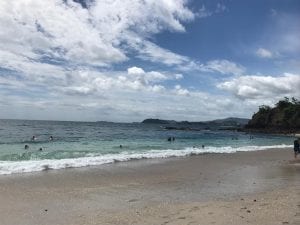This week marks the halfway point for our time in Costa Rica. It feels like we have been here a long time. I feel comfortable and settled in our apartment, I understand my role at work, and it feels like I have known my classmates for ages. I think the next 4 weeks will fly by, especially as we pack our weekends full of trips to all the beaches, rainforests and volcanoes we want to see before we head back to the States.
I would like to reflect on my time here so far and what I hope to get out of the remaining weeks. This summer in Costa Rica started with a trip to Liberia to see the healthcare system in action and to get introduced to one of the projects that Rice students have been working on here (DialOasis). On this trip, the day after landing in San José, Costa Rica, I knew I had made the right decision to do the GMI program. In learning more about peritoneal dialysis and the need for it in this region of the world, we were able to ask questions of the doctors who perform dialysis, interact with patients who undergo dialysis treatments, watch the dialysis procedure in the hospital, and think about design solutions to this complex medical and public health issue. This immersion was essential to understanding the needs of the hospital and the patients, and the key to being a successful engineer, as we are learning, is to be able to effectively identify needs.
I am feeling far removed from this immersive environment at my internship. I am gaining technical skills and learning how a big company functions organizationally, but I don’t feel that the work I am doing is unique to Costa Rica. If anything, my role in Supplier Engineering is most unique to Costa Rica because materials for production here must often be sourced locally, and I get to interact with these vendors. However, Boston Scientific designs and manufactures devices for the developed world and not necessarily for the community I live in here in Costa Rica. This is not to say that the work being done is not incredibly important and life changing to patients, because it is and I am aware of that every day. Each project I am on is working toward the development of an impactful medical device. The material change for the stent I am working on is to make patients more comfortable. The acquisition of a company I am working on will make minimally invasive cancer diagnosis an option for some people. Although I expected to do more engineering work locally, I am happy to be getting exposed to the many facets of engineering that I was not aware of before starting my internship at Boston Scientific.
I am eager to get started working on our design and implementation projects, where we will be able to work with the communities we are designing for. I will be leading the Truvent team to redesign and implement a more consistent bag-valve mask system for EMS personnel. I will also be on Kevin and Annie’s projects, both of which are based in Brazil. Kevin is leading PalliAssist, a way to facilitate palliative care between patients at home and their caregivers. Annie is leading ClaroScope, a way to improve the diagnosis of skin cancer and ensure the safe transfer of data between patients and caregivers. Each of these projects is at a different stage in the implementation process, so I look forward to getting a wide range of experiences with each one.

